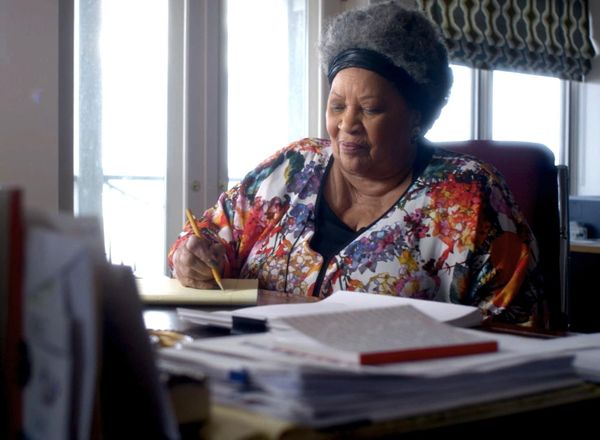 |
| Timothy Greenfield-Sanders on filming Toni Morrison: "The camerawork that was done in Toni's home by the river, all of that was done by Mead Hunt." Photo: Timothy Greenfield-Sanders |
In the second instalment of my conversation with director/photographer Timothy Greenfield-Sanders he recalls memories of Tennessee Williams, Bette Davis, Orson Welles, and Ingmar Bergman, and relates an early Ernest Hemingway insight. We discuss Fran Lebowitz, Oprah Winfrey, Walter Mosley, and Russell Banks in Toni Morrison: The Pieces I Am and his longtime cinematographer Graham Willoughby (Lou Reed: Rock and Roll Heart, The List series of films) who became Morgan Neville's trusted DP on (Won't You Be My Neighbor on Fred Rogers; They'll Love Me When I'm Dead; Yo-Yo Ma and The Silk Road Ensemble in The Music Of Strangers; Keith Richards: Under The Influence; Best Of Enemies on Gore Vidal vs. William F Buckley Jr, and the Oscar-winning 20 Feet From Stardom).
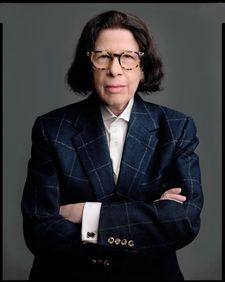 |
| Timothy Greenfield-Sanders: "When she says 'I highly recommend that you have a friend that wins a Nobel Prize!' Classic Fran Lebowitz." Photo: Timothy Greenfield-Sanders |
Timothy credits his editor Johanna Giebelhaus for the clip from John M. Stahl's Imitation of Life with Claudette Colbert being included in Toni Morrison: The Pieces I Am and he notes that Mead Hunt filmed the scenes at Toni Morrison's home.
Anne-Katrin Titze: Your documentary covers monumental awarenesses as well as smaller practical things, like the fact that Toni Morrison can only write in the morning. Was that on your list of questions, how she writes? Or did that just come up?
Timothy Greenfield-Sanders: It came up. I think it's such an insight into a writer. I remember being struck years and years ago by someone telling me that Hemingway wrote at six in the morning and stood at a lectern and wrote in longhand. And I thought, oh, is that what writers do? I was maybe 12 or something.
It's interesting that Toni feels she's smarter in the morning. Some of this of course was explained by the fact that she had young children and they were still asleep, so she'd get up super early and work and then juggle all the other stuff she had to juggle.
AKT: Did you have a list of things to ask?
TGS: No, it's kind of a conversation that keeps going and in the end we even allowed the crew to ask questions. Because everyone's there and I think it should be very open to ideas and thoughts that the crew might have. My friend from The Latino List, Sandra Guzman, conducted the interviews with Toni.
AKT: That's good. Oprah, how was she as an interview for you?
TGS: You know, Oprah gave us a half an hour. We were told we would get half an hour and she gave us a half an hour. To the second pretty much. And it was gold. And I kind of thought it would be. She did at one point tear up. And she said "I didn't expect to be crying this morning thinking about Toni Morrison. And here I am doing it."
I think that Toni means so much to her, there's a real connection between the two of them as friends and also the work moves Oprah very much.
AKT: You've worked with so many people of great fame, do you still get nervous?
TGS: No, I never get nervous.
AKT: You never did get nervous in the past either?
TGS: I learned it years ago. Never.
AKT: Since the 12-year-old learned from Hemingway? Ever since then?
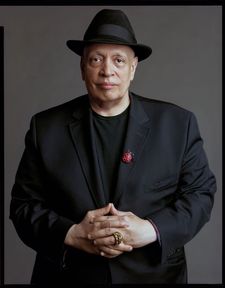 |
| Timothy Greenfield-Sanders on Walter Mosley: "He wore a hat, he had a ladybug - you know, people think about how they're going to present themselves on camera." Photo: Timothy Greenfield-Sanders |
TGS: The first person whom I met who was famous was Tennessee Williams. I was 13 years old and he was a friend of my uncle's in Key West. And I would go down to Key West to go fishing and stay at my uncle's and we'd bring the fish in in the afternoon and have dinner with Tennessee Williams.
I had no idea who he was, except that I knew he was somebody because everyone seemed to be kowtowing to him. There was a kind of like, who is this guy? And why do they care about him so much? And then I was told who he was. There was no Internet. And I sort of understood celebrity much better. Very early on.
And then at film school, we would watch every film by Bergman and then Bergman would come. And I would take the pictures for the school and you probably read the story with Bette Davis and her telling me: " What the f… are you doing shooting me from below?" All of that.
And I started to understand very quickly that these are people, this is a job I have, and I'm not going to be nervous. They're not nervous. If they are, they are nervous because they don't look good or they are fearful that they don't look good.
AKT: So the end of the Tennessee Williams story is that you have never been nervous since?
TGS: I think when I started to shoot portraits at A.F.I. and I was a student there and I was surrounded by the most famous film people of the day every day it became very normal in a sense. It was with Orson Welles that I understood my role. Because I went to shoot him and I said something really stupid like "What's your favourite film of all your films, Mr. Welles?" And he said "I don't play games like that." And like that [he snaps his fingers] I thought, he's right, that was a stupid question.
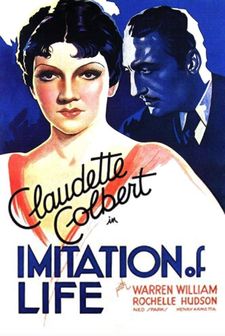 |
| 1934 Imitation Of Life poster |
I should have said: Would you like a glass of wine? Can I get you some coffee? Are you comfortable in this chair? That's who I was at that point. I was a photographer there to take his picture. I wasn't a tourist asking him to tell me something about his career. It was stupid.
Ever since that time I felt that I need to think about this person who is coming in for a portrait or the subject who is coming to sit for an interview. How do I get that person from the door to the set and feel trusting of me and the atmosphere here. It's a dance in a sense. So I'm never nervous. Celebrities see that nervousness instantly. Everyone comes to them.
AKT: Fran Lebowitz is, no surprise, a great interview.
TGS: We were looking at outtakes the other day for the DVD and we have a little section of Fran that is magnificent.
AKT: Just how she talks about going to the Nobel celebrations! And that she went!
TGS: And when she says "I highly recommend that you have a friend that wins a Nobel Prize!" Classic Fran Lebowitz.
AKT: Also that she helped her friend pick the shoes and the outfits. The fashion part is also interesting. You photographed her many times over the years. Did Toni Morrison's fashion style change?
TGS: I think Toni has always had a distinctive look. She really knows what she wants to wear and what she doesn't. I've done shoots here many many times where we brought in stuff and she said no no no no no. Even in the Charlie Rose interview, look at that one, she's wearing that leopard dress. An amazing leopard top, right?
And I asked her about it the other day and she said "I still have it." And even in the Bill Moyers one, she is wearing this bright red outfit that's very striking and she looks very good in it. Toni's very conscious of clothing and fashion. She's a public person, and I think if you're smart you think about what you wear. I can wear this, I'm not a very public person. I can wear jeans and flip-flops.
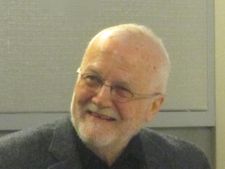 |
| Timothy Greenfield-Sanders on Russell Banks and Toni Morrison: "They're old friends and I think he gave a kind of marvellous perspective to the film." Photo: Anne-Katrin Titze |
AKT: Sure.
TGS: And nobody cares. I'm an artist, I can wear anything I want.
AKT: You mentioned leopard, it's funny, I have this theory that everybody seems to love leopard print.
TGS: Leopard consciousness we call it.
AKT: Leopard consciousness? It's crazy, from punk to old ladies.
TGS: Thinking about it, I used to wear leopard shoes in the Seventies that a friend of mine hand painted, sneakers with leopard on it. People were just shocked by it, it wasn't a consciousness. But then it kind of comes in and now it's cool.
AKT: Everywhere. The most tacky people wear it in the most awful way and the most fashionable ones. A beautiful Batsheva dress with animal print and on the other hand you see it on, I don't know, some Kardashian. But that's not really the point. I have more animal comments, though. Walter Mosley has prominently a ladybug pin. Is there a story?
TGS: I think it's just something he's been collecting a lot of and he wears different ones.
AKT: Of ladybugs?
 |
| Ed Bahlman's Lou Reed: Rock and Roll Heart VHS cassette tape from Timothy Greenfield-Sanders Photo: Anne-Katrin Titze |
TGS: Yes, he has a ladybug obsession. You have to ask him, I'm not sure. But again, he wore a hat, he had a ladybug - you know, people think about how they're going to present themselves on camera.
AKT: Graham Willoughby, your cinematographer, is the cinematographer of a lot of Morgan Neville's documentaries, Won't You Be My Neighbor, 20 Feet From Stardom, The Music Of Strangers.
TGS: He started with us way back in The Black List series and he did the interview camerawork. The camerawork that was done in Toni's home by the river, all of that was done by Mead Hunt, a different cameraman who did magnificent work I thought. Giving us these four seasons that we have there. And Graham's a friend forever now and part of our team. He's done very well. He started with us, we gave him the start.
AKT: To talk a little more about the choice of clips you made, you chose the 1934 [John M. Stahl's] Imitation of Life with Claudette Colbert and not the Lana Turner Douglas Sirk one.
TGS: Right. Very good!
AKT: It's an extremely powerful scene at that moment.
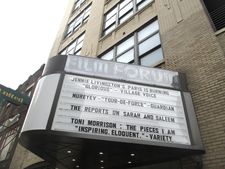 |
| Toni Morrison: The Pieces I Am on the Film Forum marquee Photo: Anne-Katrin Titze |
TGS: I chose it … My editor Johanna Giebelhaus I give credit to, who thought we should consider this. It's a piece I don't think most people know anymore. If we're in the film world, we see a lot of stuff. But this is a long long time ago. It's a film that nobody's seen, probably it's out of print. It's not part of the dialectic anymore. But it should be.
AKT: It should be.
TGS: It's an amazing film.
AKT: Russell Banks in your film surprised me.
TGS: They're old friends and I think he gave a kind of marvellous perspective to the film. I love that section where he talks about being in a prize conference, picking prize books and the two women, one black and one white, were arguing that the African American experience arriving in America was no different than any other immigrant experience.
And he's going "Are you out of your f…ing minds?" And he said that thought is still around today. People still don't have an understanding of the difference of that experience.
AKT: The focus is on some books more than others. Tar Baby doesn't get much time.
TGS: We focused on a few books.
AKT: Was it your choice or was it Toni who said, this one, not that?
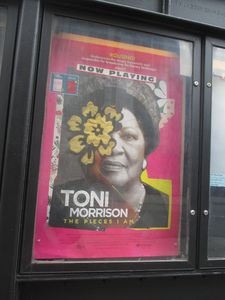 |
| Toni Morrison: The Pieces I Am poster at Film Forum Photo: Anne-Katrin Titze |
TGS: I don't think that we ever really wanted this to be about the meaning of her different books. If you really want to do that you join a book club or you go to a class, or you read yourself and make up your mind. I think this was a film about who is Toni Morrison, what has she accomplished?
We got that wonderful section where she explains the ending of Song Of Solomon. She'd never done that before. That was kind of cool, super cool. I wasn't going to go book by book and explain them. We mention Paradise, we allude to different books, we show all her books.
AKT: I am lecturing at Hunter College on fairy tales and folktales, and the Tar Baby tale is an important reference. That's why I was asking about this particular one in the tradition of storytelling. But I like that you don't go book by book. The linear isn't important.
TGS: The linear was something we were very much against and part of it is because Toni isn't linear. Toni is changing the narrator the next sentence. Toni is moving in time. Toni in her own work does that. So we thought we should take advantage of that in the film, allude to that, and not: She was born here and this is where she's at today.
Read what Timothy Greenfield-Sanders had to say on Lou Reed and Toni Morrison condensing language, filming direct-to-camera for Toni Morrison: The Pieces I Am, and what's in a gaze.
Toni Morrison: The Pieces I Am is in cinemas in the US.






















